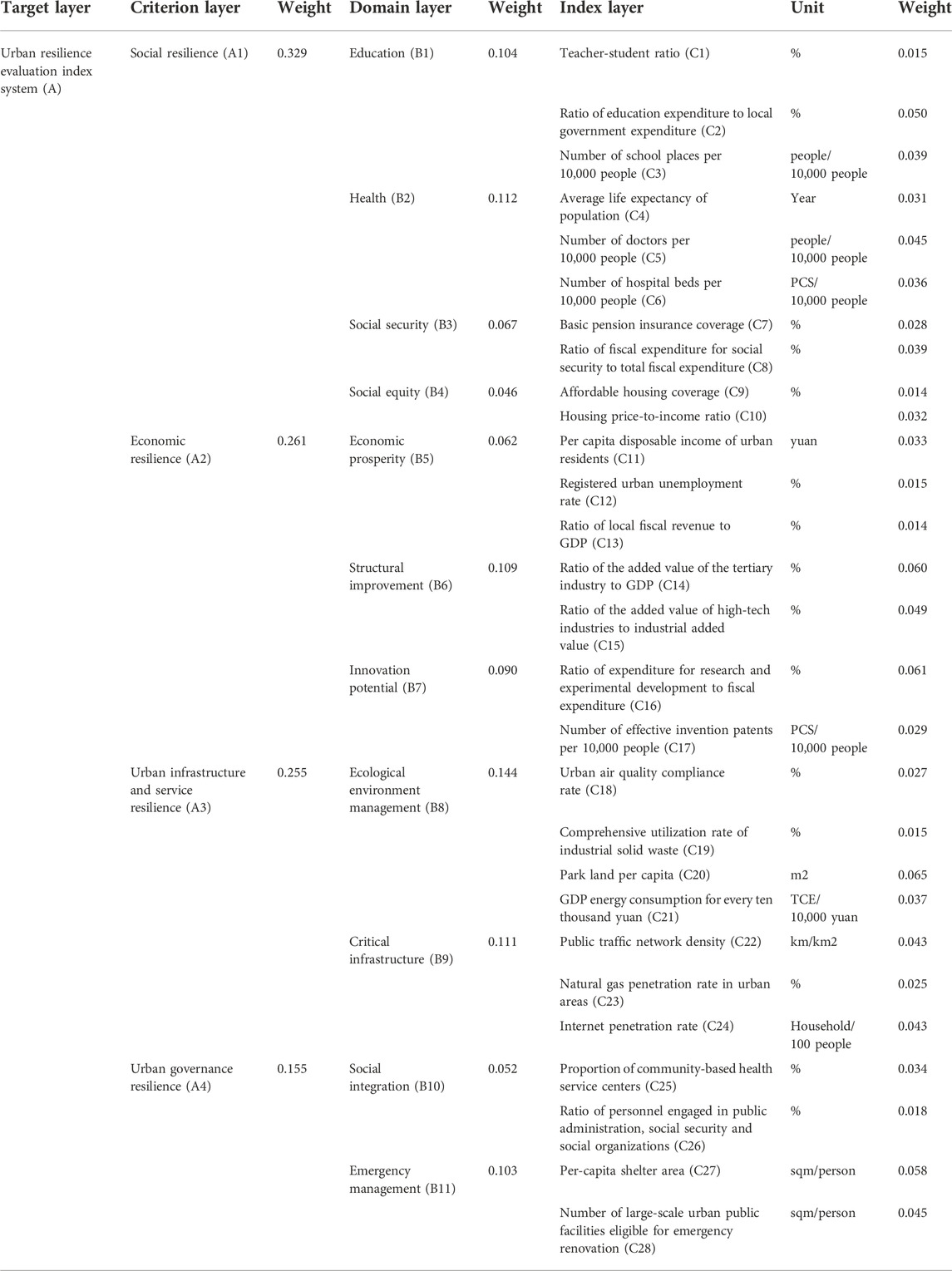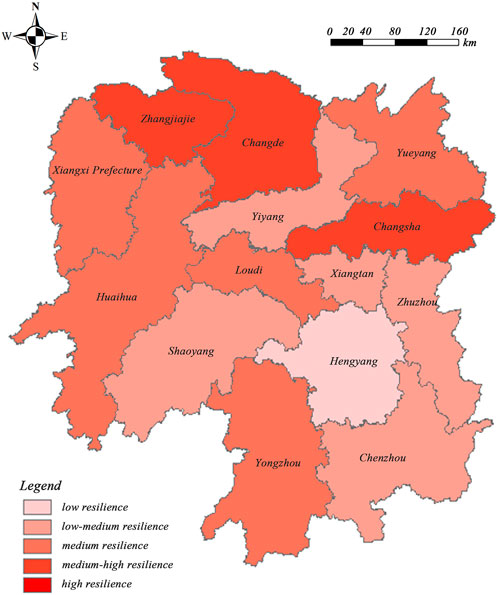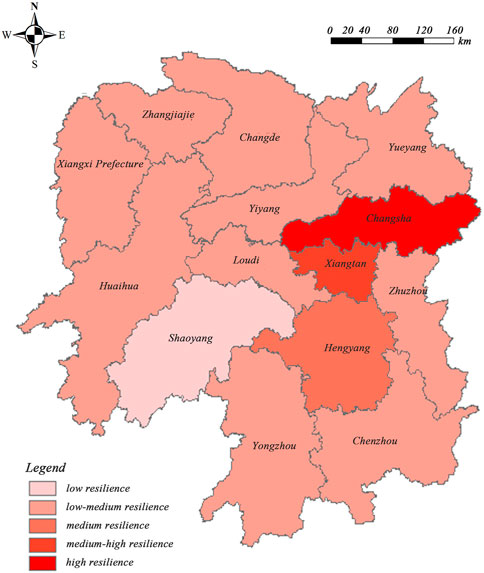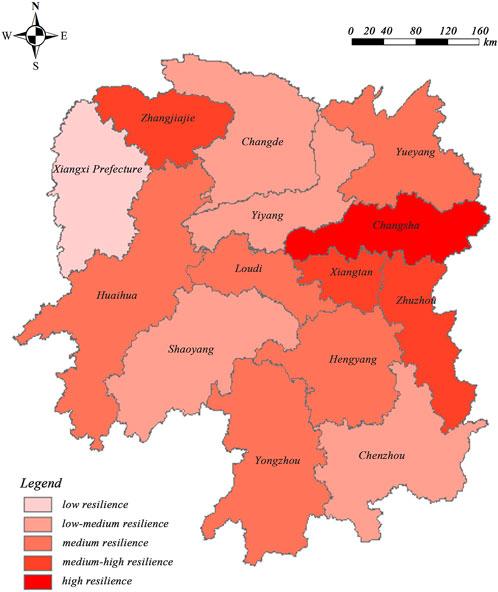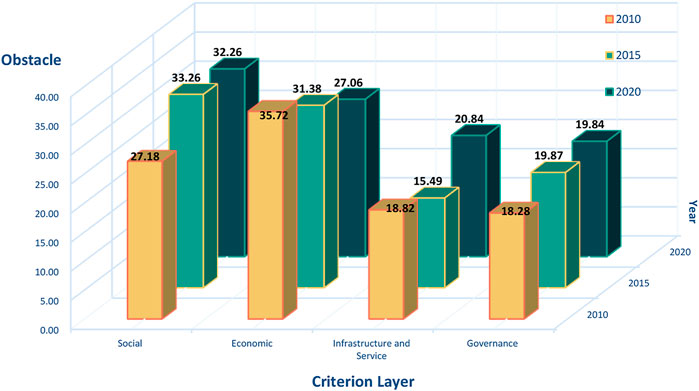- 1School of Architecture, Hunan University, Changsha, China
- 2Hunan Key Laboratory of Sciences of Urban and Rural Human Settlements in Hills Areas, Hunan University, Changsha, China
Resilient city is an ideal goal and model of urban development proposed in response to today’s complex and dynamic environmental changes. In this study, a resilient city evaluation framework of “social resilience-economic resilience-urban infrastructure and service-urban governance” was built upon the multi-dimensionality of the urban system; the entropy weight method was used to measure the level of urban resilience in Hunan Province while an obstacle degree model was used to identify any obstacle factor restricting to the development of resilience. The results show that the level of urban resilience in Hunan Province has grown slowly over the past 10 years, and there is an obvious regional difference in it. There are more and more highly resilient cities, but medium/low-resilience cities still dominate the province, forming a spatial process of evolution from “medium/high-level dispersion” to “medium/high-level aggregation” in the Changsha-Zhuzhou-Xiangtan Urban Agglomeration. The level of urban resilience is predominantly hindered by the social and economic systems; at the index layer, most obstacle factors are moving from the economic system to the social-economic-urban infrastructure and service system.
1 Introduction
At present, a profound change is taking place in science and technology, industry, energy, and finance worldwide, resulting in increasingly prominent conflicts between populations, resources and the environment. Accordingly, the world is becoming increasingly complex and unpredictable, requiring cities to keep more resilient and smarter in response to various challenges and crises. On the one hand, cities need to cope with long-term risks, but more importantly, they shall enhance their ability to tackle unknown and sudden risks, such as droughts and floods caused by extreme weather; urban damage caused by major natural disasters; intensified social conflicts caused by economic crises; social instability caused by terrorist attacks; serious impact of public health events on the urban medical system and urban governance, etc. All the resultant dynamic changes and uncertainties in urban development are universal problems faced by every city.
In today’s world, where there are all kinds of crises and uncertainties, the international community is gradually abandoning the traditional development model that mainly relies on resource degradation and environmental disruption. The concept of sustainable development is widely accepted and used to guide the practice of urban development. However, 93 environment-related indexes in the SDGs were already assessed in The Global Environment Outlook 6 (GEO-6), showing that only 20 indexes had undergone significant improvements over the past 15 years (UNEP, 2019). The environment remains under increasing pressure from growing population, economic activities and global consumption and production.
For cities, a pressing issue that needs to be solved is how to cope with various changes and crises to maintain their vitality and sustainable development. Since the beginning of the 21st century, the concept of resilience has become an important complement to sustainable development. Sustainability and resilience are closely linked (Zhang and Li, 2018). Resilience is the preferred method (Levin et al., 1998) and a necessary condition (Lebel et al., 2006) for the sustainable development of natural and social systems, bringing new impetus for understanding and recognizing the inherent complexity and uncertainty of cities.
Resilient city helps to implement the concept of sustainable development in a specific space—the “city.” Essentially, it is designed to promote the coordinated development of social-economic-natural subsystems, as well as the urban system and surrounding areas. As urbanization deepens, the complex, huge urban system is achieving optimal development to finally improve people’s wellbeing and quality of life (Cui et al., 2010). As a multi-objective and multi-dimensional development framework, sustainable urbanization focuses on the long process of development (Kanuri et al., 2016). During this process, a series of prerequisites for safe urban development should be ensured, and events such as crises and disasters should be avoided as much as possible. If avoidance is not possible, resilience must be built to resist the negative impact of these events, so that the city can maintain its daily functions (Gebre-Egziabher, 2004). Compared with sustainable cities, resilient cities are more capable of coping with specific risks. On the one hand, they have the ability to defend and create buffers against disasters, crises and uncertainties, as well as high self-recovery capacity after destruction; on the other hand, the internal development vitality of the urban system is emphasized, so that cities can find opportunities in challenges and effectively convert them into resources. Therefore, the concept of resilient city not only is compatible with several important goals that contemporary cities need to achieve, such as sustainable development, but also serves as a strong complement and extension of sustainable urbanization. It therefore provides a new idea for coping with the crisis, uncertainty and complexity of future urbanization.
2 Literature review
2.1 Resilience and resilient city
The concept of “resilience” was first proposed by the American ecologist Holling. It is the ability of an ecosystem to quickly restore back its original state and maintain its structure and function in the face of external shocks (Holling, 1973). Later, resilience achieved further deepening and development in the research areas of sociology (Dovers and Handmer, 1992; Adger, 2000; Brakman et al., 2015) and economics (Polèse, 2010; Hudec et al., 2018; Wilson and Jonas, 2018), used to describe the ability of communities or residents to cope with social, political, and economic changes. For these concepts, there is a significant difference in the scope and connotation of research, but they all agree that the most basic meaning of resilience is the ability of a system to resolve external shocks and maintain its main functions during a crisis. Moreover, by absorbing and adapting to the external shocks, restoring to its original state and learning from experience, the system can adjust itself to a new context and enter the next equilibrium state (Hudec et al., 2018).
Since the 1990s, the resilience theory has increasingly spilled over into the urban system. At first, it was used to test the vulnerability of the urban system to natural disasters, especially those caused by climate change (Colten et al., 2008). Later, it was further applied to other city systems, such as the urban social system (Waley, 2005), economic system (Pike et al., 2010), and safety system in response to growing terrorist threats (Coaffee, 2016). It was also applied to the spatial system (Cumming, 2011) and urban governance model (Klein et al., 2017), Thus began an improvement in its practical applicability, developing up a new vision of urban planning research (Davoudi et al., 2012).
2.2 Urban resilience assessment
Gunderson and Holling argue that resilience can be quantified (Holling and Gunderson, 2002) in terms of the degree of disturbance, provided that the system is able absorb disturbance and remain unchanged. The quantification, evaluation and empirical research of resilient city started after 2000. Presently, the research is in the process of exploration from theory to practice. Due to the complexity of the urban system and the universal goal of building resilient cities, the academic community has conducted continuous and diverse explorations on intrinsic dimensions and construction methods. As the Bonn Conference was held in Germany in 2010, many countries, including the United States, the United Kingdom, Australia, and Switzerland, formulated urban development strategies and policies based on resilience theory (Pestel, 2010; ARUP, 2014). Subsequently, more and more evaluation activities were held by international non-profit organizations and government agencies.
Chinese academic researchers turned their attention to resilient city in the early 21st century. At the Liberal Forum on “Risk Society and Resilient City” held during the China Urban Conference on Urban Planning in 2015, they proposed that cities should develop a comprehensive and systematic understanding of the importance of the urban resilience assessment by assessing, predicting and pre-evaluating different environment risks. Some scholars began to conduct research on resilient city assessment for China. The studies can be roughly classified into three categories: First urban resilience was measured based on different research scales, covering the whole country, urban agglomerations, cities, communities, etc (Li and Zhai 2017; Xiu et al., 2018; Zhang and Feng, 2019; Shen et al., 2021). Second, an urban resilience evaluation framework was developed from different perspectives, such as disaster management, sponge city, and geography (Zheng et al., 2018; Li et al., 2019; Li et al., 2022).Third, a discussion was made on the relationship between urban resilience and other urban characteristics, including urban space, city scale, etc (Wei and Pan, 2021; Fang et al., 2022).
Although academics have recognized the importance of urban resilience research, how to systematically and dynamically understand urban resilience remains difficult point in academic discussions. As a comprehensive and dynamically evolutionary system, urban resilience differs significantly from city to city because of regional developmental background in the presence of uncertain disturbing factors. Moreover, the dominating factors are different. Therefore, a multi-dimensional resilient city evaluation framework of “social resilience-economic resilience-urban infrastructure and service-urban governance” was built in this paper based on a comprehensive urban system; then, the entropy weight method was used to measure the level of urban resilience in Hunan Province, while an obstacle degree model was used to identify any obstacle factors to the development of resilience. Meanwhile, the dynamic changing process of the system was put under observation in an attempt to put forward relevant recommendations on enhancing urban resilience and promoting the sustainable coordinated development of intraregional cities.
3 Study area, index system construction and research methodology
3.1 Study area
According to the present status of social and economic development, China is divided into four economic regions, including East China, Central China, West China, and Northeast China. As the transition area between East China and West China, Central China comprises of six provinces including Shanxi, Henan, Anhui, Jiangxi, Hubei and Hunan. Located in the core inland area, Central China plays an important role in linking other parts of the country together. In this study, Hunan Province, part of Central China, was selected as the research object. By reference to the Statistical Yearbook of Hunan Province, the statistical yearbooks of the cities and prefectures under its jurisdiction, the Statistical Communiqué of the People’s Republic of China on the 2021 National Economy and Social Development, etc., the years 2010, 2015, and 2020 were selected for evaluation research on the urban resilience of Hunan Province and for identification of obstacle factors.
3.2 Index system construction and research methodology
3.2.1 Index system framework
Resilient city evaluation indexes provide a conceptual representation of the causes of urban resilience. Each index is designed to identify the basic elements related to resilience and explore the internal relation between resilience drivers from different perspectives. Compared with other relevant urban evaluation indexes, a resilient city should be problem-oriented and risk-targeted, and focus more on how to enhance the urban system’s resistance to multiple pressures as well as its diverse absorptive capacity. All the major constituents of the resilient city system, including the society, economy, environment, population health, policy management, and infrastructure, should be reflected in the index system, and multiple indexes should be used to form an organic whole. The index system should not only reflect the connotation of resilient city, but also comprehensively consider social economic characteristics; be not only conducive to leadership decision-making, but also highly understandable for the public.
In this study, the classification framework of the resilient city index system is defined as follows: 1) A classic classification framework widely recognized by the academic community is adopted for the index system; 2) The index system comprehensively reflects various aspects of resilient city development. Based on the above literature research and data availability, expert opinions and correlative analysis, a resilient city evaluation framework of “social resilience-economic resilience-urban infrastructure and service-urban governance” was selected. Different topics were set under each category, and 28 indexes were placed under the topics to represent the status of each topic. Finally, an evaluation index framework system was built for resilient city (Table 1).
3.2.2 Research methodology
All index data underwent dimensionless preprocessing, so as to have the same character; then, Pearson correlation analysis was conducted to remove a small number of indexes highly correlated with one another. The rationality of index weight has direct influence on the correctness of comprehensive evaluation, so the weight of each index should reflect its importance to resilient city development. In this study, the entropy weight method (Shannon, 1948) was used to scientifically determine the weight of each index. Also, an urban resilience evaluation model was built and used to measure the urban resilience of Hunan Province. Furthermore, an obstacle degree model was used to identify the obstacle factors to resilience.
(i) Data source and preprocessing
Most of the data adopted in this study came from the Statistical Yearbook of Hunan Province, the statistical yearbooks of the cities and prefectures under its jurisdiction, the Statistical Communiqué of the People’s Republic of China on the 2021 National Economy and Social Development, and the official website of each prefectural bureau of statistics. Some other data was obtained by basic information calculation.
The evaluation indexes underwent dimensionless processing in order to eliminate the difference between the indexes and make the data comparable. The calculation formula is as follows:
Let there be n years and m evaluation indexes selected for the study, So, Vij is the jth index value of Hunan Province for the ith year, where n=i (i=1.2.3……n);m=j (1.2.3……m).
If the index is a positive index, the following formula can be used:
If the index is a negative index, the following formula can be used:
where
(ii) Entropy weight method
The discreteness of data matter much if the entropy weight method is adopted for weight determination. According to the amount of information provided by indexes, the degree of dispersion between indexes can be analyzed to objectively determine index weight, thus avoiding the impact of experts’ subjective thinking to a certain extent (Toumi et al., 2017). The higher the index weight, the greater its impact on comprehensive evaluation. The calculation steps are as follows:
The p-value obtained index normalization is as follows:
The entropy was calculated. The entropy Ej of the jth index is as follows:
The G value of difference coefficient was calculated:
The weight
The comprehensive score of urban resilience was calculated. Then, the index weight was multiplied by Pij:
(iii) Obstacle degree model
The obstacle degree model, which can be used to objectively and scientifically find out any obstacle factors to a certain evaluation object (Xu J., 2002), is a mathematical method used to identify the factors restricting the development of things based on index deviation and explain the varying degree that each index hinders the evaluation system.
4 Research results and analysis
4.1 Spatial-temporal evolution characteristics of urban resilience of Hunan Province
4.1.1 Temporal evolution characteristics
By the above calculation steps, the resilience level of 14 cities in Hunan Province could be calculated for the years 2010, 2015, and 2020 (Table 2). The higher the score, the higher the urban resilience level and vice versa.
As can be seen from Table 2, the urban resilience level of each administrative region in Hunan fluctuates over time, with the majority of the cities showing a slow growth trend. Changsha had the highest resilience level, and ranked first in the 3 years. It received the highest score, 0.5950, in 2020; the city that received the lowest scores vary across the three time sections. Hengyang received a score of 0.2635 only in 2010, the lowest in 3 years, with a difference of 0.3325 from the highest value. It can be seen that the development of resilience levels in various cities is uneven and there are large differences.
Urban resilience levels can be classified into the following three evolutionary states: The first evolutionary state is that the resilience level keeps rising over time. Such cities include Changsha, Zhuzhou, Xiangtan and Hengyang, accounting for 29% of the total. The second evolutionary state is that the resilience level rebounds after a decline, showing undulating changes. Such cities account for the highest proportion, at 64%, including Shaoyang, Yueyang, Changde, Zhangjiajie, Yiyang, Chenzhou, Yongzhou, Huaihua, and Loudi, a total of nine cities. Finally, as the only weakened city, Xiangxi Autonomous Prefecture has been in a state of decline for the past 10 years.
4.1.2 Spatial-temporal evolution characteristics
In Gis software, the natural breaks classification method (Jenks, 1967) was used to divide Hunan Province into cities with low (low, low-medium), medium and high (high, medium-high) resilience (Figure 1, Figure 2, Figure 3). For the cities with high resilience, their score is 0.4042; the score of those with medium resilience is 0.3707–0.4042; the score of those with low resilience is below 0.3707.
As can be seen, there is a significant spatial difference in urban resilience, and high-resilience cities have a space radiation effect with the provincial capital Changsha as the core. Other cities are medium/low-resilience regions, but have changed in the three time sections. For example, the medium and medium/low-resilience regions in North Hunan were reduced to medium/low-resilience regions, and their score began to rise again in 2020. A continuous change takes place in the cities with low resilience, primarily including Hengyang, Shaoyang, and Xiangxi.
As can be seen from the 2010–2020 development trend, the number of cities with medium/low-resilience gradually decreased, while the number of those with high resilience increased, score increasing faster than it decreased. Therefore, the comprehensive urban resilience level of Hunan Province was on the rise. The cities with medium/high resilience were located closer to the provincial capital Changsha. This was similar to Hunan Province’s urban structure, in which “Changsha, Zhuzhou and Xiangtan,” the core cities in Hunan Province, developed together with other cities. In other words, eastern Hunan was in the lead, with its predominance gradually spreading from east to west, forming a space pattern with Xiangxi as a low-resilience region.
4.2 Identification of major obstacle factors for urban resilience of Hunan Province
A targeted urban resilience optimization strategy was put forward in order to further identify the weaknesses of urban resilience development to help city managers prioritize the construction and development of various urban systems in accordance with urban needs. The obstacle degree of all 2010–2020 obstacle factors was calculated. Due to limited space, the top 6 obstacle factors were selected and arranged in order. See (Table 3) for details.
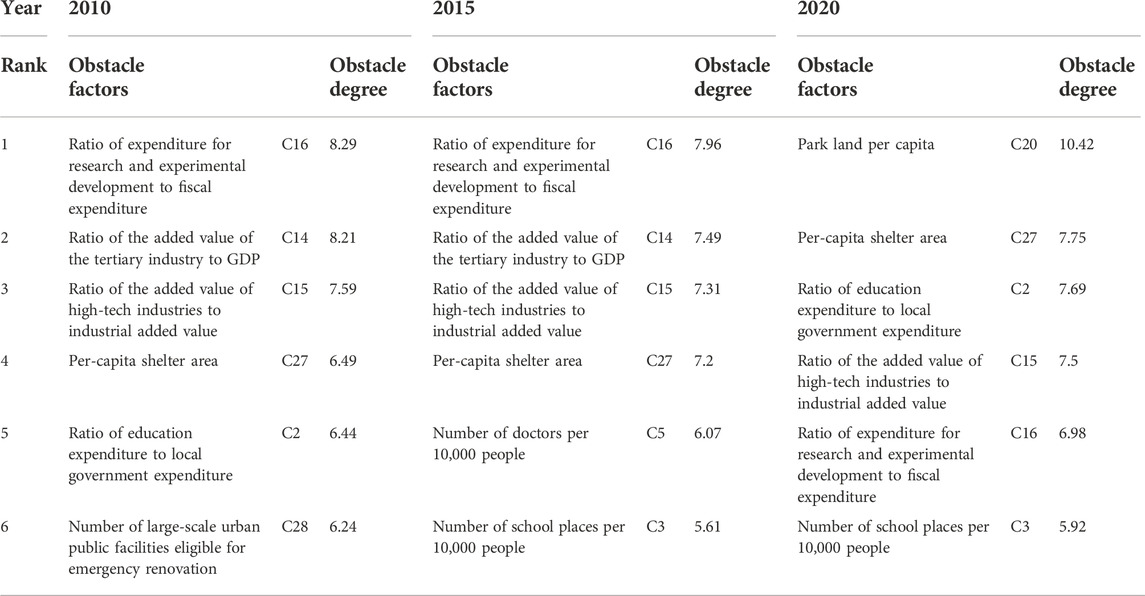
TABLE 3. Rank order list of major obstacle factors to the development of urban resilience in Hunan Province Unit: %.
4.2.1 Obstacle type recognition on criterion layer
As can be seen from the 3D diagnostic results of obstacle factors on the criterion layer (Figure 4), urban resilience is primarily hindered by the social and economic systems. The two systems of urban infrastructure and services and urban governance are weak obstacles. In 2010, the economic system brought about the greatest obstacle, 35.72%. From 2010 to 2020, with the continuous development of the economy, the obstacle degree of the economic system showed a downward trend, while that of the social system and infrastructure system rose in a wave-like manner, and that of the urban governance system gradually increased. Thus it can be seen that rapid urbanization enhanced economic resilience, leading to a decline in the obstacle degree of the economic resilience system. However, the construction of the society, infrastructure and service and urban governance lagged behind, with the obstacle degree undulating, becoming an important factor affecting the urban resilience of Hunan Province. Although the obstacles degree of the economic system tends to gradually reduced compared with other systems, due to the original poor foundation and the low overall level of the urban economy in Hunan Province, its expenditure on education, medical care and social security is limited. Therefore, the social and economic systems would play a leading role in dominating the urban resilience level for a long time.
4.2.2 Obstacle type recognition on index layer
Judging from the diagnostic results of obstacle factors on the index layer, from 2010 to 2015, the top three obstacle factors affecting the urban resilience of Hunan Province were the ratio of expenditure for research and experimental development to fiscal expenditure (C16), the ratio of the added value of the tertiary industry to GDP (C14), and the ratio of the added value of high-tech industries to industrial added value (C15), suggesting that Hunan Province should focus on optimizing its economic structure and tap economic innovation potential in order to enhance its urban resilience.
In 2020, the park land per capita (C20) appeared among major obstacle factors, and became a first obstacle factor restricting the development of urban resilience. The ratio of expenditure for research and experimental development to fiscal expenditure (C16), which had its obstacle degree lowered to a small extent, ranked behind. The per-capita shelter area (C27) and ratio of education expenditure to local government expenditure (C2) obstacle degree increased to some extent, mainly due to the fact that infrastructure construction failed to keep pace with the fast development of urban economy in Hunan Province. In general, the obstacle factors to the development of urban resilience from 2010 to 2020 transitioned from the economic system to the social-economic-urban infrastructure and service systems.
5 Conclusions and suggestions
5.1 Conclusions
(1) In terms of time, the urban resilience level of Hunan Province has increased at a slow pace over the past 10 years; the overall level is not high, and there are differences from city to city; the provincial capital city Changsha has obvious development advantages and ranks first in terms of resilience level. Zhuzhou and Xiangtan have had their resilience level significantly improved with the construction of a new urban system centered on the Changsha-Zhuzhou-Xiangtan Urban Agglomeration. Other cities, especially non-regional central cities, generally have a low resilience level. In terms of space, there have been more and more cities with high resilience over the past 10 years, but the cities with low or medium-resilience still occupy a dominant position, forming a spatial process of evolution from “medium/high-level dispersion” to “medium/high-level aggregation” in the Changsha-Zhuzhou-Xiangtan Urban Agglomeration.
(2) Over the past 10 years, the level of urban resilience in Hunan Province has mainly been hindered by the social and economic systems, but the degree of economic system obstacles has improved with the development of the economy, while the other three system obstacles have shown a fluctuating increase. From the perspective of obstacle factors on the index layer, from 2010 to 2015, the major obstacle factors were the ratio of expenditure for research and experimental development to fiscal expenditure, the ratio of the added value of the tertiary industry to GDP, and the ratio of the added value of high-tech industries to industrial added value, which are part of the economic system. In 2020, the above major obstacle factors were replaced by those in the social-economic-urban infrastructure and service system, including the per-capita shelter area and ratio of education expenditure to local government expenditure.
5.2 Suggestions
Considering the evaluation results of Hunan Province’s urban resilience and the diagnostic results of obstacle factors, the following suggestions are put forward in order to improve the urban resilience and sustainable coordinated development of cities in Hunan Province:
(1) Support non-central cities and stabilize the development of the cities with medium/high resilience. On 24 February 2022, the Changsha-Zhuzhu-Xiangtan Metropolitan Area Development Plan was officially approved, meaning that Changsha, Zhuzhu and Xiangtan can achieve further regional integration. In the long run, it is necessary to actively exploit the surrounding cities with medium/low resilience, such as Hengyang, Yueyang, Changde, Yiyang, Loudi, etc., to build a greater metropolitan area “with Changsha, Zhuzhu and Xiangtan as the core to drive the integrated development of Northeast Hunan,” so as to greatly improve the urban resilience level of Hunan Province and the city agglomerations in the middle reaches of the Yangtze River. Non-central remote cities, such as Chenzhou, Huaihua, and Zhangjiajie, can build themselves into a second echelon of resilient cities in Hunan Province with the aid of their unique resource advantages and location characteristics. As a low-resilience city, the Xiangxi Prefecture should make full use of its local features to keep promoting rural revitalization. The opening of the Zhangjiajie-Jishou-Huaihua High-speed Railway at the end of 2021 will also significantly promote the economic vitality of the northwest region.
(2) Reduce the obstacle degree of the major economic and social systems. Regarding the economic system, it is necessary to focus on optimizing the economic structure and tapping economic innovation potential. On the one hand, Hunan Province should strengthen reasonable supply and guarantees in the industrial space to build an important national highland of advanced manufacturing, so as to establish a modern industrial development pattern with core leadership, rational division of labor and high agglomeration efficiency. On the other hand, it is necessary to insist on innovation, place an emphasis on human resources, carry on the supply-side reform with technological innovation, and promote the optimization of industrial structure and the transformation of economic development to achieve a balance between supply and demand, so as to realize high-quality economic development. As for high-tech industries, it should give prominence to industries and key projects, establish high-tech industrial advantages, promote industrial restructuring and increase the industrial scale, strengthen industry-university-research integration, etc. On this basis, it is necessary to steadily improve the social system, enhance the fair and reasonable allocation of public resources such as education and medical care, ameliorate the active social policy system, and carry out a policy reform in social security, pension service, employment support, etc.
(3) Strengthen infrastructure and service construction to enhance the efficiency of urban governance. Public traffic networks, Internet communication projects, public parks, etc., which are closely related to the public, provide vitality for urban development, and are of great significance to the improvement of urban resilience. The advent of a risk society has put forward new demands and requirements for urban governance, while the emergence of major public health emergencies, such as COVID-19 pandemic, has constituted a direct tests on the level of urban governance. Through more intensive and efficient institutional arrangements, as well as IT-based urban public management and services, economic resilience, social resilience and facility resilience can be combined together organically by urban governance under the construction of resilient cities, so that the cities can obtain resilient forces that enable them to renew, recovery and develop themselves.
The significance of the evaluation of urban resilience level lies in a more scientific and comprehensive assessment of a city’s adaptability to external changes and self-regulation capabilities. This study has certain limitations. This is first manifested in dependency on the accumulation and accuracy of basic statistical data on population, socioeconomic status, environment, infrastructure, etc. However, in the current period of rapid urbanization, Chinese cities all have difficulties in collecting data or lack existing data. Therefore, when selecting indexes, we tried to consider choosing those included in the scope of government monitoring. Second, owing to a large gap in urbanization among different regions in China, it is hard to use a unified standard to evaluate cities that differ greatly. In this index system, there are many indicators that are common in the current index systems of international organizations. Although every city agrees with a set of basic indexes during the evaluation, each city also needs to screen or expand the indicator system according to the characteristics and policy preferences of the specific city, so as to better serve the development and construction of resilient city.
Data availability statement
The datasets presented in this study can be found in online repositories. The names of the repository/repositories and accession number(s) can be found below: HUNAN STATISTICAL YEARBOOK 2020: http://tjj.hunan.gov.cn/hntj/tjsj/tjnj/202011/t20201130_13972011.html HUNAN STATISTICAL YEARBOOK 2015: http://tjj.hunan.gov.cn/hntj/tjsj/tjnj/201605/t20160506_3818593.html HUNAN STATISTICAL YEARBOOK 2010: http://tjj.hunan.gov.cn/hntj/tjsj/tjnj/201103/t20110315_5295798.html.
Author contributions
NC: Proposed research propositions, designed experiments, drafted papers, and revised key academic contents; HG: Collect experimental data, conduct experiments and analyze the results; HX: Finalizing and proofreading the article.
Funding
This work was supported partially by the National Natural Science Foundation of China (No. 51908202). All opinions are the responsibility of the authors alone.
Conflict of interest
The authors declare that the research was conducted in the absence of any commercial or financial relationships that could be construed as a potential conflict of interest.
Publisher’s note
All claims expressed in this article are solely those of the authors and do not necessarily represent those of their affiliated organizations, or those of the publisher, the editors and the reviewers. Any product that may be evaluated in this article, or claim that may be made by its manufacturer, is not guaranteed or endorsed by the publisher.
Supplementary material
The Supplementary Material for this article can be found online at: https://www.frontiersin.org/articles/10.3389/feart.2022.1033441/full#supplementary-material
References
Adger, W. N. (2000). Social and ecological resilience: Are they related? Prog. Hum. Geogr. 24 (3), 347–364. doi:10.1191/030913200701540465
Brakman, S., Garretsen, H., and van Marrewijk, C. (2015). Regional resilience across Europe: On urbanisation and the initial impact of the Great Recession. Camb. J. Regions, Econ. Soc. 8 (2), 225–240. doi:10.1093/cjres/rsv005
Coaffee, J. (2016). Terrorism, risk and the global city: Towards urban resilience. Routledge. Oxfordshire, England, UK.
Colten, C. E., Kates, R. W., and Laska, S. B. (2008). Three years after Katrina: Lessons for community resilience. Environ. Sci. Policy Sustain. Dev. 50 (5), 36–47. doi:10.3200/envt.50.5.36-47
Cui, S. H., Li, F. Y., Yu, Y. X., and Lin, J. (2010). Theoretical thinking on urbanization and sustainable urbanization. Urban Stud. 3, 19. doi:10.3969/j.issn.1006-3862.2010.03.004
Cumming, G. S. (2011). Spatial resilience: Integrating landscape ecology, resilience, and sustainability. Landsc. Ecol. 26 (7), 899–909. doi:10.1007/s10980-011-9623-1
Davoudi, S., Shaw, K., Haider, J., Quinlan, A., Peterson, G., Wilkinson, C., et al. (2012). Resilience: A bridging concept or a dead end? Planing Theory & Pract. 13, 299–333. doi:10.1080/14649357.2012.677124
Dovers, S. R., and Handmer, J. W. (1992). Uncertainty, sustainability and change. Glob. Environ. Change 2 (4), 262–276. doi:10.1016/0959-3780(92)90044-8
Fang, Y. L., Su, X. Q., Huang, Z. F., and Guo, B. B. (2022). Structural characteristics and resilience evaluation of tourism flow networksin five major urban agglomerations in coastal China: From the perspective of evolutionary resilience. Econ. Geograrphy 42 (02), 203–211. doi:10.15957/j.cnki.jjdl.2022.02.022
Gebre-Egziabher, A. (2004). Sustainable cities programme: A joint UN-habitat-UNep facility on the urban environment with participation of the Dutch government. Ann. N. Y. Acad. Sci. 1023 (1), 62–79. doi:10.1196/annals.1319.016
Holling, C. S., and Gunderson, L. H. (2002). Panarchy: Understanding transformations in human and natural systems. Washington, DC: Island Press.
Holling, C. S. (1973). Resilience and stability of ecological systems. Annu. Rev. Ecol. Syst., 25 1–23. doi:10.1146/annurev.es.04.110173.000245
Hudec, O., Reggiani, A., and Šiserová, M. (2018). Resilience capacity and vulnerability: A joint analysis with reference to Slovak urban districts. Cities 73, 24–35. doi:10.1016/j.cities.2017.10.004
Jenks, G. F. (1967). The data model concept in statistical mapping. Int. Yearb. Cartogr. 7, 186–190.
Kanuri, C., Revi, A., Espey, J., and Kuhle, H. (2016). Getting started with the SDGs in cities: A guide for stakeholders. JSTOR.
Klein, B., Koenig, R., and Schmitt, G. (2017). Managing urban resilience. Informatik-Spektrum 40 (1), 35–45. doi:10.1007/s00287-016-1005-2
Lebel, L., Anderies, J. M., Campbell, B., Folke, C., Hatfield-Dodds, S., Hughes, T. P., et al. (2006). Governance and the capacity to manage resilience in regional social-ecological systems. Ecol. Soc. 11 (1). doi:10.5751/es-01606-110119
Levin, S. A., Barrett, S., Aniyar, S., Baumol, W., Bliss, C., Bolin, B., et al. (1998). Resilience in natural and socioeconomic systems. Environ. Dev. Econ. 3 (2), 221–262. doi:10.1017/s1355770x98240125
Li, Y., Chen, W., and Sun, Y. (2019). New reflections on the analysis of regional resilience in geographical sciences from a relational-dynamic perspective. Geogr. Res. 38 (7), 1694–1704. doi:10.11821/dlyj020180256
Li, Z. Z., Fu, D. F., Wang, J. X., Min, K. D., and Zhang, J. Y. (2022). Urban resilience assessment model for waterlogging disasters and its application. J. Tsinghua Univ. Sci. Technol. 62 (2), 266–276. doi:10.16511/j.cnki.qhdxxb.2021.22.037
Li, Y., and Zhai, G. F. (2017). China’s urban disaster resilience evaluation and promotion. Planners 33 (8), 5–11. doi:10.3969/j.issn.1006-0022.2017.08.001
Pestel Institut (2010). Regionale krisenfestigkeit: Eine indikatorengestützte bestandsaufnahme auf der ebene der kreise und kreisfreien städte. Hannover: Selbstverlag.
Pike, A., Dawley, S., and Tomaney, J. (2010). Resilience, adaptation and adaptability. Camb. J. regions, Econ. Soc. 3 (1), 59–70. doi:10.1093/cjres/rsq001
Polèse, M. (2010). The resilient city: On the determinants of successful urban economies. London: Forthcoming Press.
Shannon, C. E. (1948). A mathematical theory of communication. Bell Syst. Tech. J. 27 (3), 379–423. doi:10.1002/j.1538-7305.1948.tb01338.x
Shen, L. N., Tian, Y. P., and Du, Y. X. (2021). Resilience reconstruction of old communities based on resilience system. Urban Probl. 8, 45–54. doi:10.13239/j.bjsshkxy.cswt.210805
Toumi, O., Le Gallo, J., and Rejeb, J. B. (2017). Assessment of Latin American sustainability. Renew. Sustain. Energy Rev. 78, 878–885. doi:10.1016/j.rser.2017.05.013
Waley, P. (2005). The vulnerability of cities: Natural disasters and social resilience. Geogr. J. 171, 190. doi:10.4324/9781849773379
Wei, S. M., and Pan, J. H. (2021). Network structure resilience of cities at the prefecture level and above in China. Acta Geogr. Sin. 76 (6), 1394–1407.doi:10.11821/dlxb202106006
Wilson, D., and Jonas, A. E. (2018). Urban resilience: An urban political movement. Urban Geogr. 39 (8), 1265–1267. doi:10.1080/02723638.2018.1452873
Xiu, C. L., Wei, Y., and Wang, Q. (2018). Evaluation of urban resilience of Dalian city based on the perspective of "Size-Density-Morphology. Acta Geogr. Sin. 73 (12), 2315–2328. doi:10.11821/dlxb201812004
Xu, J. H. (2002). Mathematical methods in contemporary geography. 3rd Ed. Beijing: Higher Education Press.
Zhang, M. D., and Feng, X. Q. (2019). A comparative study of urban resilience and economic development level of cities in Yangtze river delta urban agglomeration. Urban Dev. Stud. 26 (1), 82–91. doi:10.3969/j.issn.1006-3862.2019.01.017
Zhang, X., and Li, H. (2018). Urban resilience and urban sustainability: What we know and what do not know? Cities 72, 141–148. doi:10.1016/j.cities.2017.08.009
Keywords: resilient city, sustainable development, entropy method, spatial-temporal evolution, obstacle factors
Citation: Chen N, Guo H and Xiang H (2023) Evaluation of urban resilience level and analysis of obstacle factors: A case study of Hunan Province, China. Front. Earth Sci. 10:1033441. doi: 10.3389/feart.2022.1033441
Received: 31 August 2022; Accepted: 24 October 2022;
Published: 16 January 2023.
Edited by:
Guang-Liang Feng, Institute of Rock and Soil Mechanics (CAS), ChinaReviewed by:
Yan Zhang, Chengdu University of Technology, ChinaPongsakorn Suppakittpaisarn, Chiang Mai University, Thailand
Copyright © 2023 Chen, Guo and Xiang. This is an open-access article distributed under the terms of the Creative Commons Attribution License (CC BY). The use, distribution or reproduction in other forums is permitted, provided the original author(s) and the copyright owner(s) are credited and that the original publication in this journal is cited, in accordance with accepted academic practice. No use, distribution or reproduction is permitted which does not comply with these terms.
*Correspondence: Na Chen, Y2hlbm5hODI1QGhudS5lZHUuY24=
 Na Chen
Na Chen Hongxia Guo
Hongxia Guo Hui Xiang1,2
Hui Xiang1,2